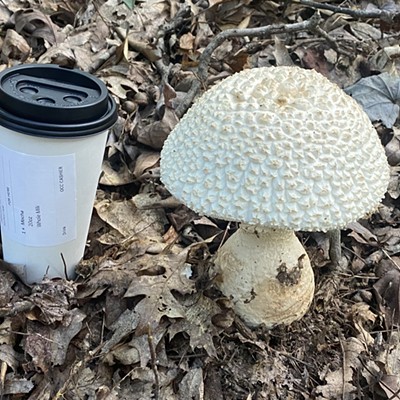In case it’s escaped anyone’s notice, Pittsburgh has been overrun by spotted lanternflies. As the adult pests began emerging in mid July this year, seemingly every news outlet released a story about the invasive insects — first identified in Allegheny County in 2020 — encouraging residents to keep swatting. Meanwhile, photos circulated of lanternflies swarming office buildings, overtaking yards, and thronging the Dunkin Donuts in Oakland. Despite our best efforts at population control, it seems — anecdotally at least — that the spotted lanternfly, native to Asia, has only gained a greater foothold locally.
September marks the beginning of lanternfly egg laying season, and in the short term, that means more scraping and squishing. Longer term, enterprising residents have dreamt up some creative solutions.
Pittsburgh City Paper asked Emelie Swackhamer, Senior Extension Educator and horticulture expert at Penn State Extension (part of the College of Agricultural Sciences), about the feasibility of more, let's say, extreme methods of spotted lanternfly management seen on social media and elsewhere.
Army of Predators
Recently, photos have cropped up of spiders and insects feeding on spotted lanternflies, with praying mantises, wasps, and wheel bugs — a species of “assassin bug” — all on the attack. Birds including woodpeckers, catbirds, blue jays, Northern cardinals, and tufted titmouses have also been observed eating the invasive bugs. And a recent Penn State study revealed a few other surprise predators such as chickens, squirrels, bats, frogs, garter snakes, and goldfish.
Could we cultivate a large number of predators to wipe out the spotted lanternflies? On an individual level, could someone simply buy a bunch of praying mantises to release in their yard?
“This idea of biological control is something a lot of people are interested in,” Swackhamer says. “It’s kind of fun to see a praying mantis eat [a lanternfly], it’s fascinating … but I don’t think the financial return is there.” (Swackhamer notes that in the case of the praying mantis, one non-native species — the Chinese Praying Mantis — was already introduced in Pennsylvania more than a century ago as a pest control agent and is still considered invasive by some.)
However, scientists are working on locating parasites from lanternflies’ “native range,” but must proceed “very careful[ly]” to prevent further ecological upset. They’re also experimenting with using fungi as a commercial myco-insecticide — including a species of cordyceps, of The Last of Us fame — but so far, Swackhamer says, have seen “inconsistent results.”
In the meantime, Swackhamer recommends thinking holistically about your garden or yard and “using practices that encourage other wildlife and insects to live there.” Having “a diversity of plant material in your landscape,” cultivating native plants, and limiting toxic pesticides all help provide a supportive habitat for the animals already preying on lanternflies.
Pets for Pests
For another potential solution from the animal kingdom, cats, dogs, and pets have been sighted hunting spotted lanternflies. Could they be corralled for the cause?
Another biological control, Swackhamer says pets “killing [lanternflies] and leaving them dead is fine … it’s like people stomping on them.”
But when it comes to eating them — dogs specifically have been reported to chomp large numbers — Swackhamer cautions that the bugs’ exoskeletons are not digestible, encouraging pets to stick to the kill.
In terms of making a dent in the lanternfly population,“[it’s] probably not going to make a big deal of difference,” Swackhamer says. “But if it keeps your cat entertained, I don’t see any harm.”
Remove Every Tree of Heaven
One of the spotted lanternfly’s “very favorite host plants,” the Tree of Heaven, is an invasive plant “in its own right,” Swackhamer says. In theory, it makes sense to cut off lanternflies from their best food source, with some communities even exploring programs to provide residents financial assistance for Tree of Heaven removal.
However, displacing lanternflies from a Tree of Heaven doesn’t necessarily prevent them from colonizing other plants.
“It depends on what other trees are around,” Swackhamer explains. “We haven't [seen] any proven way [to measure] if you remove X number of Tree of Heaven, you might see a reduction of X percent of lanternfly.”
Still, if you can afford it, Swackhamer says removing a Tree of Heaven is “a good thing to do.”
Chemical Warfare
Beyond biological controls, Pittsburghers have taken to chemical methods. One cheap homemade solution proliferating on the internet is to fill a spray bottle with water and a high concentration of dish soap, rumored to kill lanternflies on contact.
Swackhamer doesn’t encourage this, as dish soap can contain colorants and antibacterial compounds, both of which damage plants. Penn State has also been approached about vinegar, bleach, and even kerosene — including for flamethrowers and weed burners — which pose hazards to humans too.
“If you burn all the leaves on a plant, you’ve done more damage to your tree than the lanternflies may have done,” Swackhamer points out.
Instead, she recommends a slower-acting insecticidal soap, tested for safety on plants (Penn State Extension maintains a guide on its website).
“Everybody likes to see the dramatic, rapid death of the spotted lanternfly, like Wile E. Coyote with the Xs in the eyes and a poof of smoke,” Swackhamer says. “These softer products don't always give you that satisfaction, but you just have to have a little patience.”
Saw-style Traps
Where you can really see resourcefulness on display, Swackhamer says, is with so-called mechanical methods — traps, bait, and other devices. Generally, these are encouraged, because they kill lanternflies without using pesticides. The caveat is they can be costly and — as with other methods — not see much efficacy. Electric bug zappers are largely ineffective, for example, and lanternflies aren’t attracted to black light.
Swackhamer saw a tennis racket device that shocked lanternflies but was unconvinced it worked any better than an old fashioned flyswatter.
“That’s really better for the environment than an electric device where we're potentially burning fossil fuels,” she tells City Paper.
A bottle catcher like those used to attract fruit flies also yields mixed results. Flypaper inadvertently captures birds and other animals.
Instead, Swackhamer recommends a circle trap, which draws lanternfly nymphs — who instinctively climb to tree canopies — up a tunnel and into closed container. It’s a good example, she says, of a solution that considers the entire ecosystem.
“The ecology is one big functioning unit and you have to evaluate how your actions affect all parts of the environment,” Swackhamer says.
The final word on reducing the local lanternfly population? “Kill them if you can, but use safe methods,” Swackhamer says.














